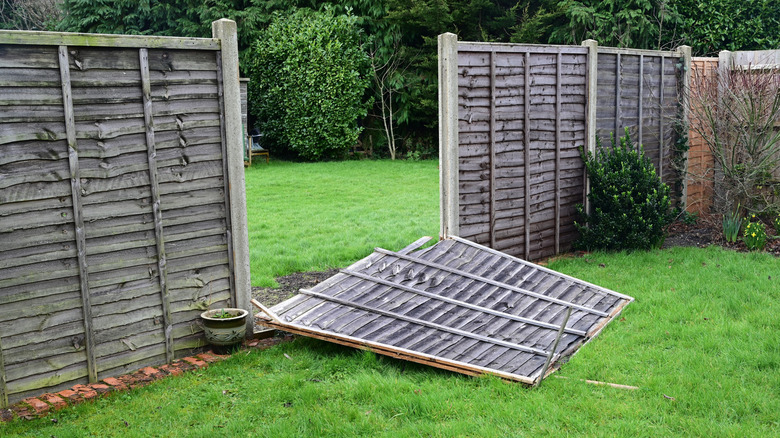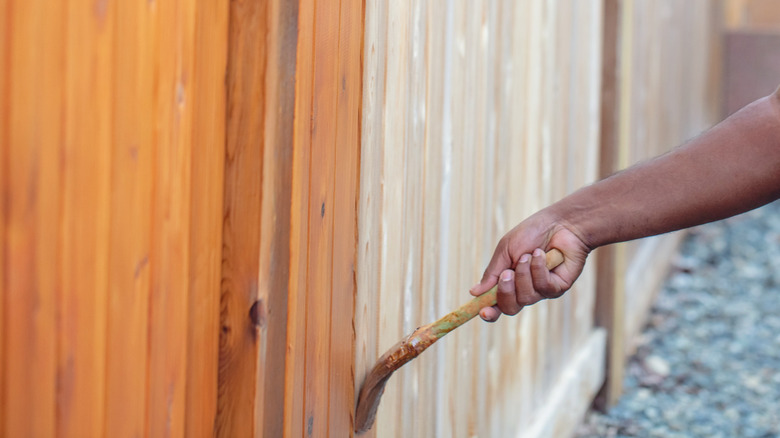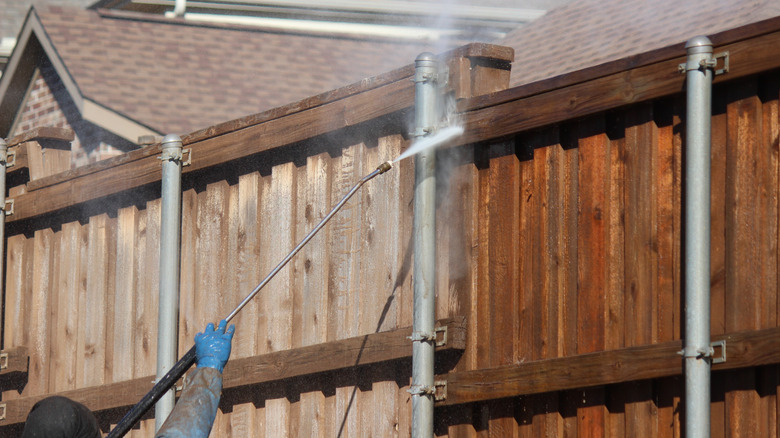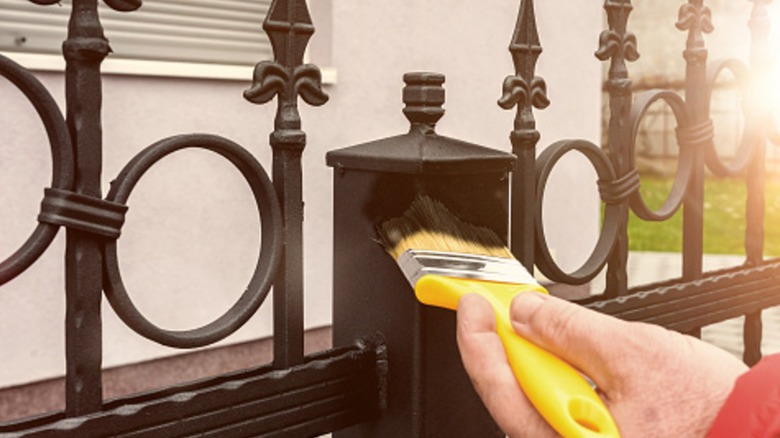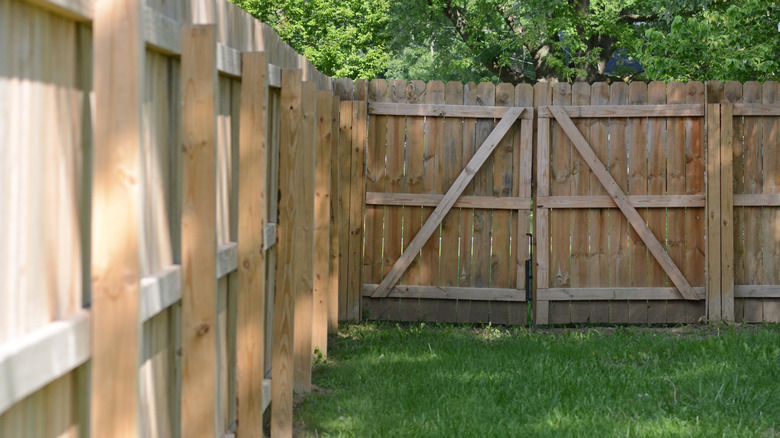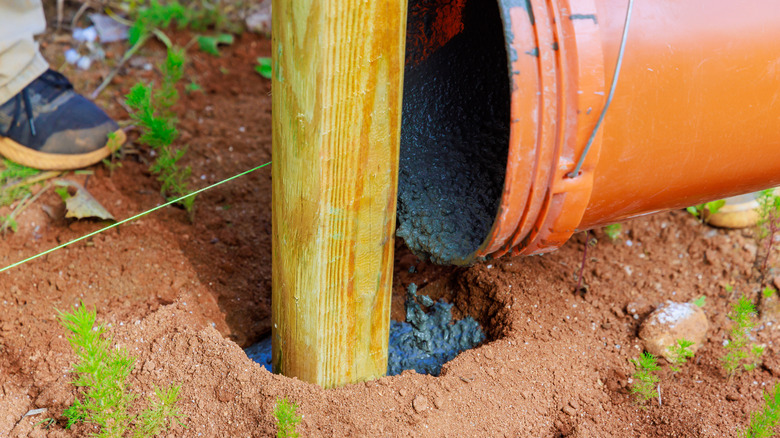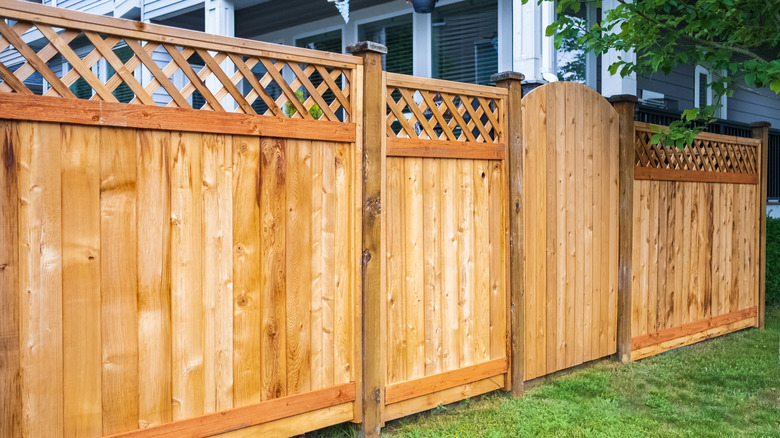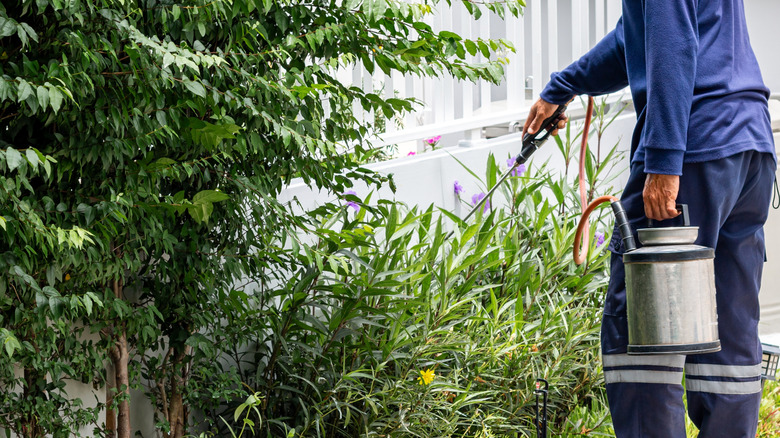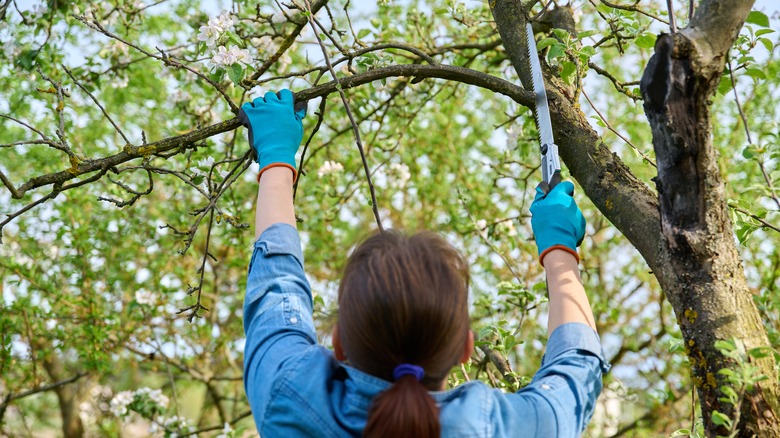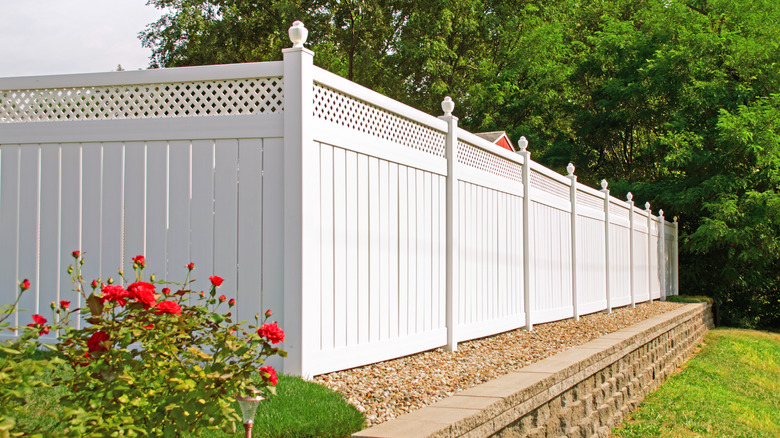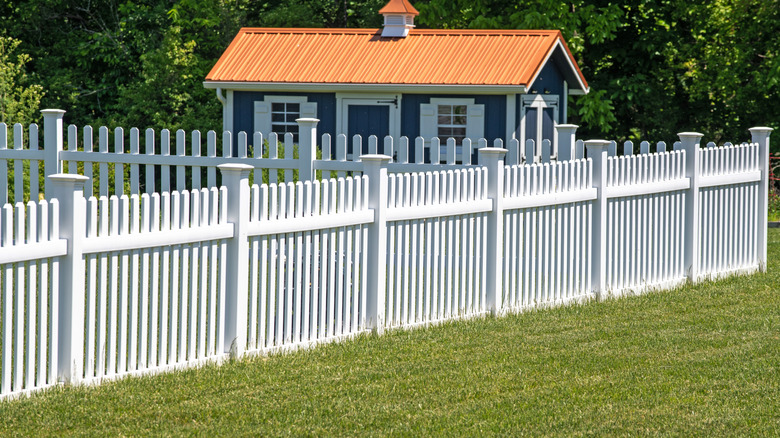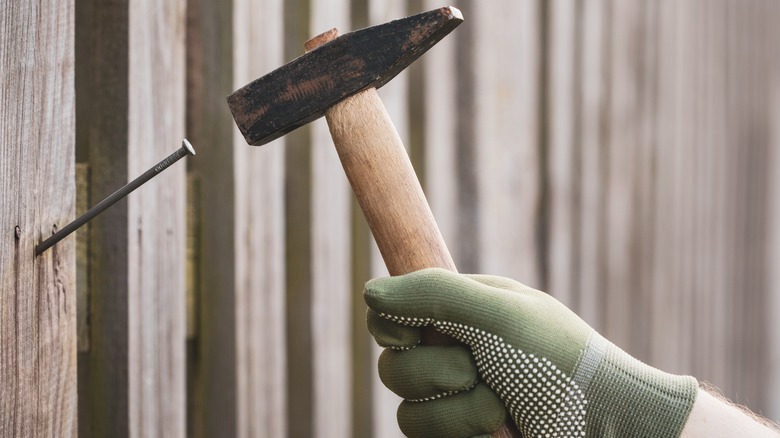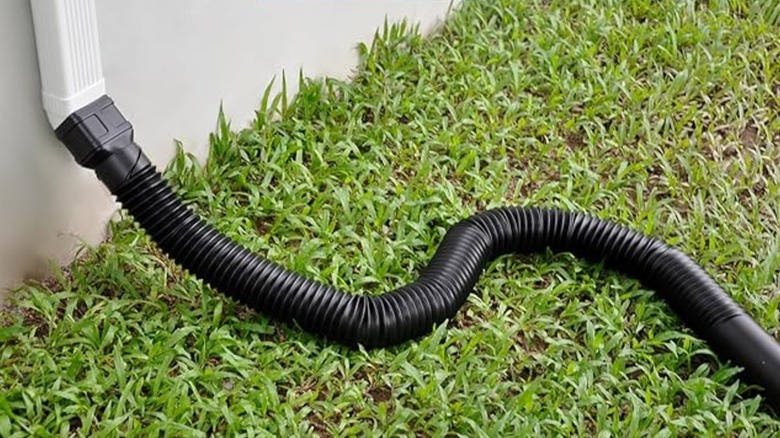Prevent Common Fence Damage With These Simple Tips
We may receive a commission on purchases made from links.
Installing a new fence is a major investment — and not something that you want to do frequently. However, rotting wooden boards, rusty metal bars, leaning posts, broken sections from fallen tree limbs, and various other types of damage can all threaten the longevity of your fence. Even if replacement isn't necessary, a costly repair may be. That is, unless you take measures to prevent these potential (and common) issues from becoming a problem in the first place.
While it may be impossible to predict what the future holds, there are specific types of damage that fences are most likely to experience. Wood fences are prone to rot and moisture-related issues and can be targeted by pests. Steel and wrought iron fences' main enemy is rust, and vinyl fences are vulnerable to UV damage. And things like shifting poles and falling tree branches can affect all types of fences. Fortunately, many of these problems can be avoided by following recommended installation guidelines and carrying out regular care and maintenance. The following tips will help you create a consistent and effective routine to care for it. If you're still in the planning phase for a new fence, you'll also find some construction and material selection tips to ensure a long-lasting installation.
Routinely stain timber fences to prevent wood rot
One common problem with timber fences is rotten boards or posts. Wooden fences are susceptible to both dry and wet rot. Dry rot occurs when the sun and wind cause the wood to get overly dry and brittle. The boards may practically crumble when touched if the rot has progressed far enough. Wet rot, on the other hand, is caused when wood is exposed to too much moisture — often at the base if it remains wet for too long following a rainstorm or because of water collection.
You can easily tell if a wooden fence is rotting, and, fortunately, it's also relatively simple to protect it against both dry and wet rot. Regular staining is one of the most important wooden fence maintenance tips. It can help the boards and posts maintain their structural integrity, safeguarding the fence from moisture damage while also preventing harmful UV rays from drying out the wood and turning it brittle. Regular staining can also help combat water marks, which occur from rain or winter precipitation penetrating the wood, marring its appearance. Aim to stain your fence about once a year. Depending on the climate in your area and the specific sun, heat, and moisture conditions your fence is exposed to, you may need to stain it more frequently — or find that you can go a bit longer between staining.
If you've never stained a fence, deck, or other large item, the prospect may seem daunting. While you could hire a professional, there are also some tips and products that can keep it from being too overwhelming. For example, using a product like Wood Defender Transparent Fence Stain that doesn't run or drip negates the need for back-brushing and can make application easier. Additionally, investing in a sprayer, like the Wagner Spraytech Stain Sprayer, can further simplify the process and cut down on how long it will take you to stain your fence.
Regularly cleaning timber fences can prevent harmful mold buildup
Mold is something no homeowner wants to think about. Whether it is in the basement, in the bathroom, or on the fence, mold is a serious problem. With fences, specifically, mold can compromise the structural integrity. The more the microorganisms are able to spread, the larger and more serious the problem will become. If left unchecked, a mold problem could potentially cause the boards to crack, the wood to crumble, or even result in sections falling down.
If you want to avoid such mold-related problems, it is essential to establish — and stick with — a regular cleaning routine. Removing debris from the surface will eliminate the conditions in which mold thrives. Wet leaves, for example, can trap moisture against the fence, creating an environment that is prime for mold growth. Regularly rinse the fence off to keep it clear of debris, and consider hiring a professional to pressure wash it (or do the job yourself) about once a year. Be sure to schedule a power washing before applying a new coat of stain to ensure the surface is prepped and ready.
Applying a protective coating to metal fences can prevent rust damage
While wooden fences can rot, metal ones are prone to rust. A rusty fence is unsightly; it can be a major threat to your home's curb appeal. However, aesthetics aren't the only concern to worry about with a rusty fence. The rust can actually cause more serious problems. Rusty rails may not be able to fully do their job and maintain the support needed to keep the structure standing. Severely rusted and corroded bars can even snap off, leaving shards of metal exposed.
The best way to prevent metal and wrought iron fences from rusting is to apply a protective coating. Seal any exposed metal with a rust-resistant primer. Then, you apply a few coats of a durable topcoat to further protect the fence against rust and corrosion. Enamel, epoxy-based paint products, and outdoor acrylic latex paints are the main options. If you spot signs of rust on an existing fence, be sure to remove the corrosion before priming and painting the metal. This can be done by scrubbing the affected areas using sandpaper and a wire brush, removing it with a grinder (you can even attach a wire cup brush to an angle grinder), or using a rust remover, like the Rust-Oleum Rust Dissolver Gel Formula to save you some elbow grease.
Prevent wooden gates from sagging by installing a diagonal brace
Over time, wooden gates may start to sag. This can be a serious concern. If the gate is sagging, that means it is also no longer lined up properly with the sides of the fence and you might not be able to latch the gate securely. Beyond making your property less secure (or at least your backyard a less safe place to let pets run free), a sagging gate can also be an eyesore and hard to operate.
Proper installation is essential if you want to prevent your gate from sagging. Adding a diagonal brace to the gate will make it less flexible and better ensure that it holds its shape. In order for this brace to be most effective, run it from the bottom hinge to the opposite top corner. This orientation provides compression to the joints between the rails and the brace to keep everything more securely lined up. Another important thing to remember when installing this diagonal brace is that you should use exterior wood screws. While you may be using nails to attach the rest of the fence boards, wood screws will offer a longer-lasting hold for a gate, unlike nails that could begin to loosen after a few years.
Prevent fence posts from tilting by setting them into the ground with concrete
Tilting fence posts is another issue that no homeowners want to deal with. In addition to not looking particularly attractive, leaning posts may put large sections — or even the entire structure — at risk of falling. There are a few potential causes of leaning posts, including wood rot, soil erosion or shifts, and heavy winds.
Once again, installing the fence properly in the first place is the best way to prevent the posts from tilting over time. If you're thinking about skipping on cement when installing your fence, you might want to reconsider. When you set the posts in concrete, they'll be less prone to tilting, even if the ground around them shifts or changes over time. If you're DIYing a new fence or replacing a leaning post, you might consider using something like Quikrete's Quick Setting Cement, which doesn't require the mixing that is needed with regular cement (you can simply pour the cement powder into the hole around the pole and then add water). You'll still want to follow the proper guidance when inserting the posts. Start by digging the holes for the posts to be between ⅓ and ½ of the above-ground height (so, between 2 and 3 feet for a 6-foot fence) Add an additional 6 inches to this measurement to account for the recommended layer of gravel that should be added before the concrete to ensure proper drainage around the posts. The width of the hole should be roughly three times the diameter of the post.
Add back rails to a wooden fence to keep it from warping
Over the years, a wooden fence can start to warp. The individual boards begin to bend, giving it a very asymmetrical look. Beyond not looking very pleasant, this can also threaten the overall durability of the structure. As one or two start warping, more are likely to follow. If too many boards become warped, the integrity of the fence may weaken, potentially causing it to collapse. The reason fences warp is typically due to moisture causing the boards to expand and contract.
One preventative measure that should be taken during installation is to add back rails. These rails should run perpendicular to the posts and boards, helping to keep everything in place. At a minimum, you'll want to add two sets of back rails — one about 8 inches below the top of the fence, and one about 8 inches above the base. Depending on the height, an additional rail in the middle can further protect against warping (this is typically only necessary in fences that are 8 or more feet tall).
Use a borate-based product to protect against pest damage in timber fences
Time and weather aren't the only things that can threaten the structural integrity of a timber fence. Pests can also target the wood, potentially causing enough damage to destroy entire portions of it or necessitate costly repairs. Some particular species to watch out for include termites, carpenter ants, various beetle species, horntail wasps, and carpenter bees. If you find small holes in a fence, this can indicate a pest problem – other signs of damage may include wood shavings, insect wings, powdery coatings on the wood, or a hollow sound when you tap.
To protect your fence, apply a borate-based treatment, such as the Nisus Bora-Care. These wood treatments work to kill potentially damaging pests and penetrate into the wood to offer continued protection. They can also help to stall wood rot. You will need to reapply the treatment once a year, as borate wood treatment products are water-soluble.
Trim surrounding trees regularly to prevent falling limbs from damaging a fence
If a tree falls on a fence and no one is there to see it, will it still cause damage? Unfortunately, we all know the answer to that question. Beyond the more devastating damage that can be caused by an entire tree falling on a fence, downed limbs and branches can also cause serious issues. Depending on how and where they land, falling branches can bend boards or even break sections of a fence.
While you can't control nature, trimming your trees regularly can minimize how many limbs they drop during storms. If you've noticed, many of these dropped limbs are often dead. So, if you remove them before they fall or get blown off, you can avoid much of the potential threat they pose to your fence. With a saw and a pruning tool (something like the Fiskars Power Lever Extendable Pole Saw and Tree Pruner can allow you to reach branches without scaling the tree), you can take care of a lot of the trimming yourself. However, you may want to consider hiring a professional tree-trimming company to cut off large branches or those that are higher up in the canopy where you won't be able to reach safely, even with a ladder. Wondering what to do if a neighbor's tree is overhanging your garden or fence? You can legally trim any portions that extend over your fence. However, you won't be able to enter their property to trim these off. The best thing to do would be to speak with your neighbor and develop a plan to trim back any branches that are a threat to either of your properties.
Opt for vinyl fencing materials with UV inhibitors to prevent cracking and discoloration
Vinyl fences are a relatively durable and low-maintenance option. However, one common problem they often face is cracking and discoloration. The UV rays from the sun are strong. So strong that it can cause the color of the vinyl to fade over time. This will give your fence a dull and outdated look even if it is only a few years old. UV radiation can do more than just detract from the overall look, though. It can also damage the vinyl material itself. As the sun rays beat down on the vinyl year after year, they can make it brittle and more likely to crack.
Fortunately, there is a relatively simple fix to prevent such devastating damage to a vinyl fence. It starts with choosing the best materials. Look for vinyl fencing that is protected by UV inhibitors. These inhibitors absorb the UV rays from the sun and disperse them away from the vinyl. To make sure you're not falling prey to false marketing, prioritize products that have warranties for UV damage specifically.
A lot of online guides also recommend that you seal your fence with a UV protectant product. However we were unable to find any widely available products designed for vinyl fences, and going over your entire fence with cans of Sun Guard doesn't sound very cost-effective. Additionally, there isn't any data available on how UV protectant sprays or sealants might interact with vinyl planks. Therefore, we'd advise speaking with your fence installer before applying any UV sealant products.
Maintain a clear area around your fence to guard against pests and moisture damage
As noted above, both pests and moisture can pose a serious risk to a fence. When there is a lot of vegetation touching the base of the fence, it can make both of these problems more likely. Pests can travel to the wooden boards from overgrown grass or shrubs that are touching them. Water can also remain trapped, creating a damp environment and keeping the boards wetter than they would remain if the moisture were able to evaporate more quickly with increased airflow.
So, to avoid either of these potential problems, it is important to keep the fence line clear of vegetation. Trim back any bushes or other plants that are growing right up against it, kill pesky weeds, and keep your grass trimmed along the base. While the best way to maintain the fence line will vary based on the specific type(s) of growth that you're dealing with, a pair of loppers (like the Fiskars 15-inch PowerGear Loppers) or a hand pruner (like the Felco Classic Manual Hand Pruner) may be able to help. In addition to clearing back vegetation, you'll also want to avoid piling anything up against the fence, such as firewood, garden waste, kayaks, and children's toys. Anything that is pressed up against the fence can impede airflow, preventing it from being able to dry out as quickly after a rain.
Use blunt nails when repairing or adding boards to a timber fence to reduce splitting
Repairing wooden boards or adding new ones is an important part of maintaining your fence. However, if you use the wrong type of nails for these repairs, you may be opening yourself up to new problems. While most people probably assume that sharp nails are better because they're, well, sharp, they actually aren't ideal to use on fencing. When the sharp nails penetrate the wood, they're more likely to cause it to split or splinter.
Instead, try opting for blunt nails (such as these 2-inch Screw Shank Blunt Chisel Point Nails from Amazon) when you next need to make any repairs or replacements on your timber fence. Because of their shape, blunt nails exert less sideways pressure into the wood. Unfortunately, blunt nails aren't all that easy to find in the U.S. If you can't buy a pack of blunt nails, and are worried about splitting planks in your fence while making repairs, the safest route is to drill pilot holes and use screws. Screws are also the most long-lasting option. If you do opt for regular nails, make sure they have screw shanks. Screw shank nails have enhanced holding power and are better able to grip into the wood, making them less likely to fall out as your fence expands and contracts in response to the elements.
Direct water away from your fence line to reduce moisture-related damage
Moisture is a common cause of wood rot, as we've explained before. Moist environments are also more welcoming to many pests. Therefore, if the area around the base of your fence stays wet for long periods of time, you're opening the door to a range of negative consequences.
Some variables — like several rainy days in a row — may be out of your control. However, there are certain changes you can make to minimize the amount of water accumulating along the fence. One relatively simple change is to redirect downspouts so they do not run toward the fence. If they're directed at the wooden boards or iron poles, then all of the water that runs through your gutters during a storm is going to end up pooling around the fence line. Similarly, if you have sprinklers or irrigation systems in your yard that are sending too much water towards the fence, consider repositioning them a bit farther away. Finally, if the slope of your yard causes water to pool and accumulate along the fence line, consider installing a French drain.
